“Golden Temple of the Good Girls” is the last quilt (besides the final installment of Marabou Stork) to receive the Quilt Story treatment before it and ten other “Specimens” quilts are shown at the 2016 International Quilt Festival in Houston in just a few weeks. This quilt of three of our pets—budgie Kiiora, dog Kali, and cat Djinni—has proven itself quite versatile as an example in several different blog posts. From finding inspiration, choosing fabric for fabric collage, and picking a good photo to base your quilt on, to how pets influence our lives, I’ve used the quilt repeatedly to illustrate my points.
Despite its multiple appearances here already, I felt that “Golden Temple of the Girls” deserved its own post.
So, instead of recreating the wheel, I decided I’d combine the existing material into one consolidated blog post. Here’s how “Golden Temple” worked its way into no fewer than four previous posts.
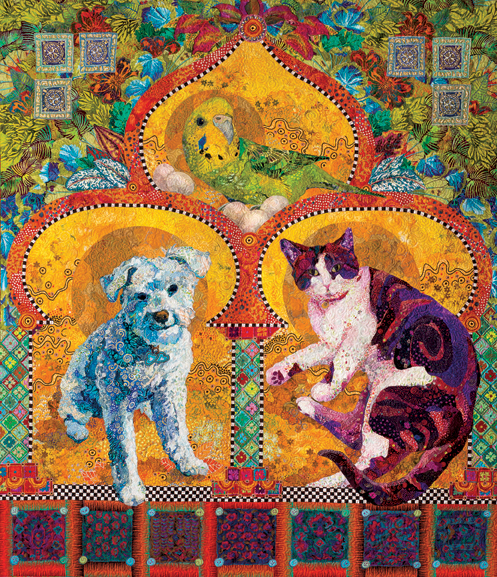
The Point of Pets
“Golden Temple” was the perfect quilt to use when talking about pets and using pets as subject matter. Here I was describing how I decided to do a portrait of the three after losing Pippin, another pet who has her own quilt, “Dixie Dingo Dreaming.”
Since I hadn’t been thinking about and preparing for this quilt for years, I didn’t have a picture of it in my head. It occurred to me pretty early on to combine our three pets into one quilt. But how? They aren’t necessarily best buddies. They don’t hang out or play together. Pretty sure the cat would eat the bird without a twinge of conscience and she disdains the dog. They needed to be separated somehow, yet combined.
I also considered how precious pets are to us as a society. There’s so much people are willing to do for pets. In fact, many of us elevate our pets nearly to the point of sainthood. In our family, the older we get and the more animals we say goodbye to, the more lenient we are with the ones we have. The three little girls we had then were treated as little princesses.
The idea of enshrining them, putting them on their own golden pedestals seemed to fit the thoughts and sentiments that I had when I considered their importance to me. So I decided on an arabesque temple. I love that onion-dome architecture. Tiles and curved arches came to mind. The surrounding structure of the portrait started to come together.
Then I had to find photos of each. What kind of poses fit their personalities? The dog sitting, waiting for us to play with her. The cat lounging. The bird poised and alert.
One interesting challenge I had when creating this piece: How would I deal with the white on both Kali dog and Djinni cat? Kiiora bird was easy. Her bright plumage made my work relatively simple. But how do you give depth and form to white? Besides, I don’t think I own any white fabrics.
The solution was to not use white, as such, but to use light values of other colors to indicate shadows. Oil and watercolor painters will tell you there’s no such thing as a “gray” shadow anyway. They always reflect color. For Kali I chose blue as her color. For Djinni it was purple and pink.
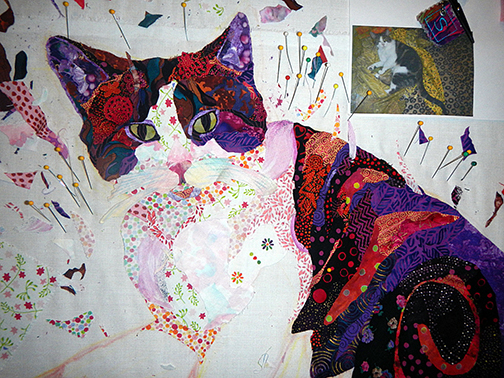
For those of you who have read my post “Why Color Is Irrelevant,” you’ll understand how a good grasp of value opens up your choice of colors.
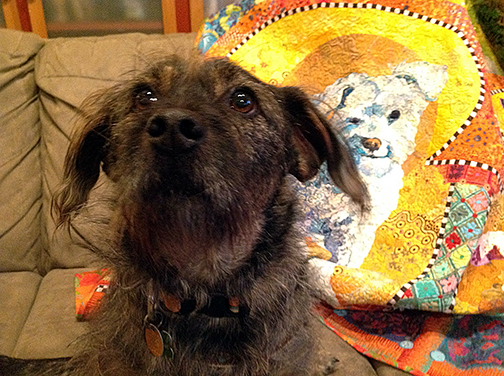
Lots of my students choose to do portraits of their pets. They make great subject matter. The love that these people have for their animals shines through. And that’s exactly the point of pets. They aren’t models or subjects for art primarily. We keep pets in order to love them and to have them love us back.
From Photo to Fabric: Choose the Best Shot
I also used “Golden Temple” to show how to choose photos for subject matter when creating a fabric collage quilt.
Let’s say you have multiple pets that you want to include in a single quilt. Are you going to take on the Sisyphean task of trying to get one photo of all of them? Let’s say you have a dog, a cat, and a bird. Still want to try it? It would be like that brain teaser involving ferrying a fox, a goose, and a bag of grain across a river.
The obvious solution is to use three (or more!) different photos and combine them. That’s what I did with “Golden Temple of the Good Girls.”
Here’s Kiiora the budgie.
And Djinni the cat on a pile of “Crocodylus Smylus” fabric.
And Kali the mini-Schnauzer.
Exposure and contrast are fine on all three photos, giving me nice highlights and shadows to work with. Cropping is fairly tight and there is good detail for re-creating their furred and feathered textures.
In fact, I only made one substantial change. Here I used to two photos of Kali to get the perfect composition. I liked the pose of Kali’s body in the photo above, but I preferred the cock of her head in this one:
As discussed before, here’s my solution for how to combine the three pets into one quilt:
Kiiora obviously had to go at the top, in the peak of the temple, with her clutch of eggs (which, yes, she’s laid eggs, and no, they don’t hatch). Kali and Djinni each occupy a niche in the shrine down below. Notice how each breaks the “frame”: Kiiora and Djinni’s tails and Kali’s paw help bring them forward in the composition.
Choosing Fabric for Fabric Collage
I used Kali dog from “Golden Temple of the Good Girls” to show how I use the patterns and colors in fabrics to create shape and form. In this case, I used captioned photos that showed just what portions of the fabric I used.
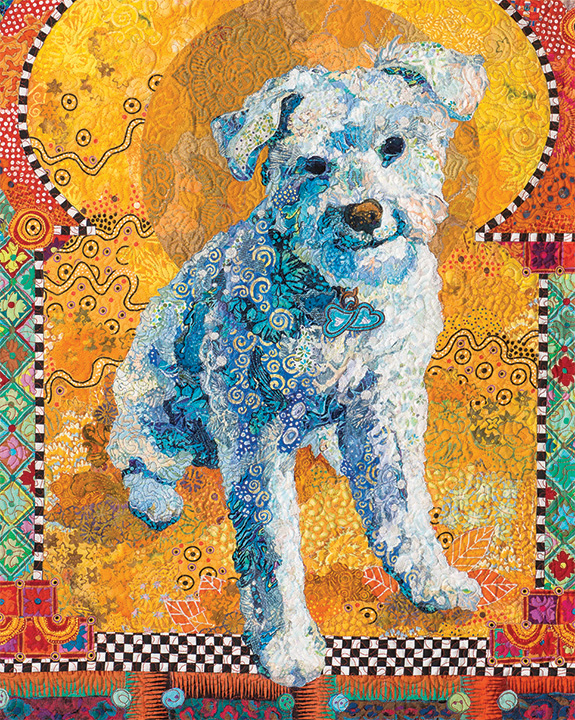


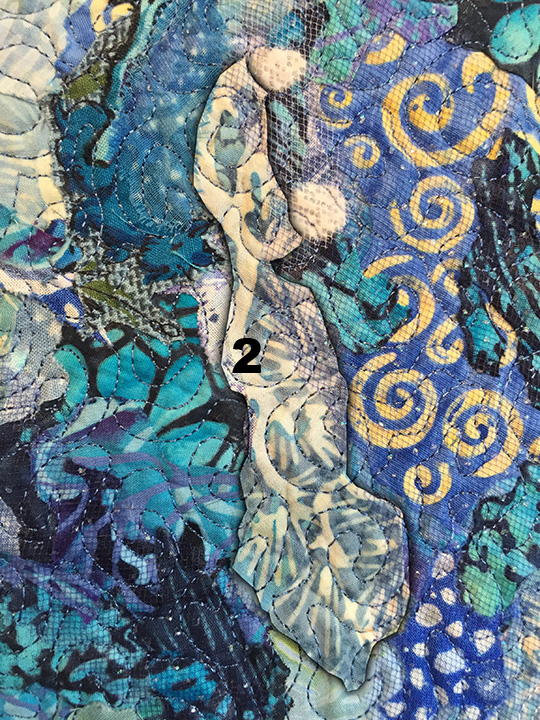


“Bird by Bird”: How I Use a Book on Writing to Teach Fabric Collage
In an early post, I mentioned “Golden Temple” in using Ann Lamott’s book Bird by Bird to inspire students in the classroom.
As a writer, Lamott thinks in drafts, with each representing a stage of the journey, which helps discourage excessive perfectionism too early in the process. In fabric collage, it’s impossible to know for certain whether that first piece of fabric you use is actually the right one. It might not be. It might have to be covered up or replaced once you make some progress. But that first piece of fabric is important even if it turns out to be wrong:
Almost all good writing [or fabric collage] begins with terrible first efforts. You need to start somewhere. Start by getting something—anything—down on paper [or muslin]. A friend of mine says that the first draft is the down draft—you just get it down. The second draft is the up draft—you fix it up. You try to say [show] what you have to say [show] more accurately. And the third draft is the dental draft, where you check every tooth, to see if it’s loose or cramped or decayed, or even, God help us, healthy.
You have to start somewhere, and it’s often the hardest part. So you put a piece of fabric here, and another one there, and it starts to look like it’ll never work. I refer to this beginning of the down draft as the “messy-scary” stage. And it can be daunting.
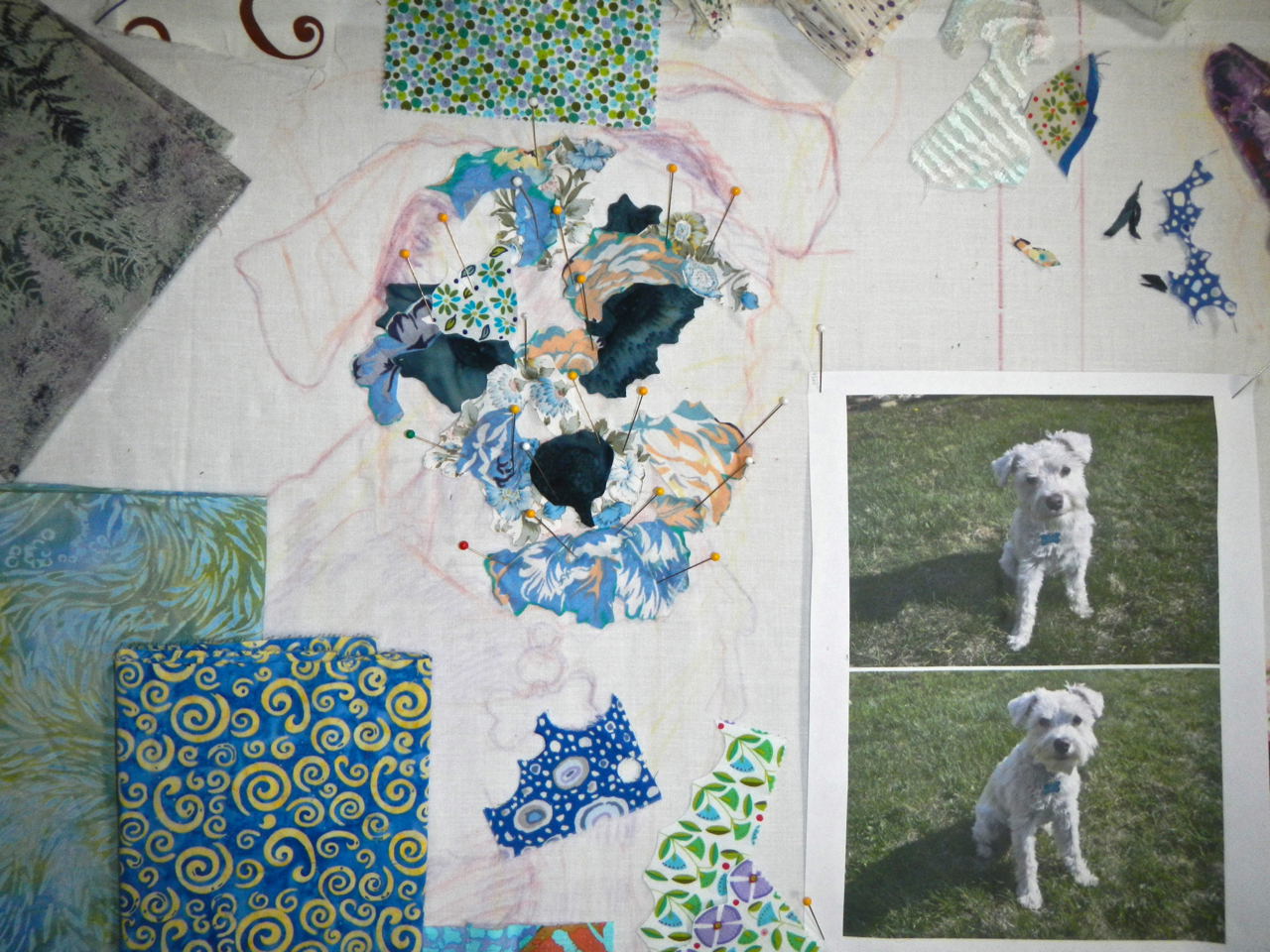
Kali the dog at the messy-scary stage is hard to imagine as a cute white mini-Schnauzer. It’s at this point that some novices run into a wall. Heck, I do, too. It’s hard to believe that it will ever look any better.
But when we keep going we eventually reach—or pass through—the down draft. The piece is blocked in. The big picture is coming clear. The muslin is covered. Here are Djinni the cat, Kali the dog, and Kiiora the budgie at the finish of the down draft:
Art—whether writing or visual—isn’t formulaic. My quilts—and I suspect Lamott’s books—don’t always follow a structured and organized path to completion.
Kali the dog hit each signpost pretty much on schedule—down draft, up draft, and dental draft.
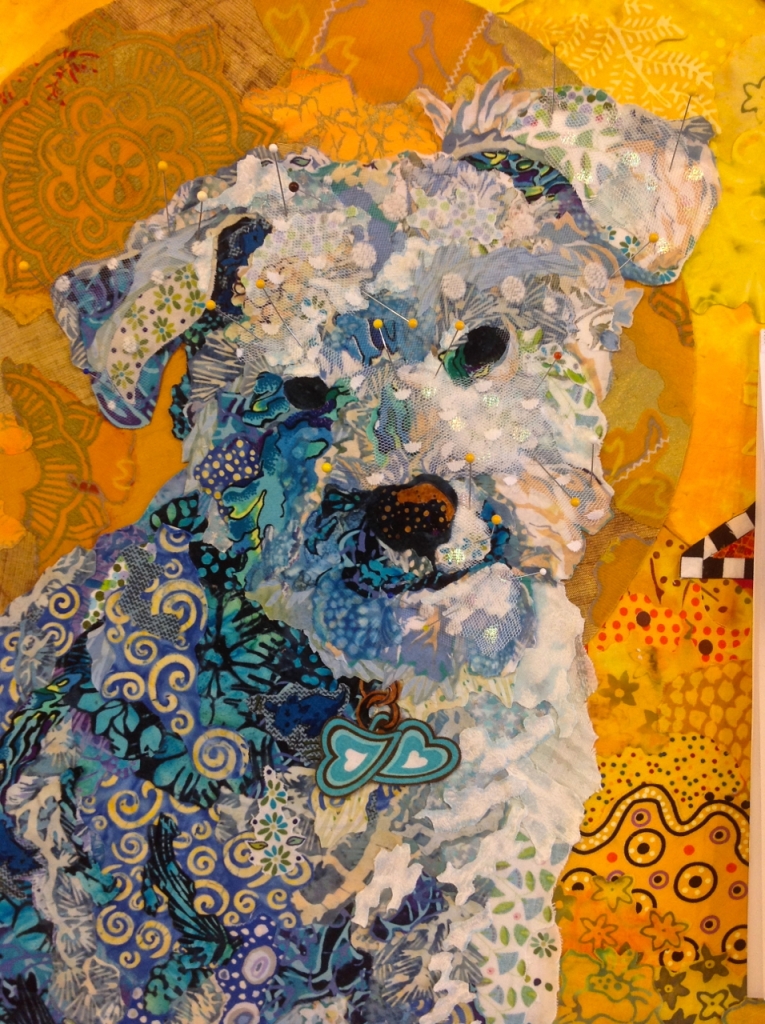
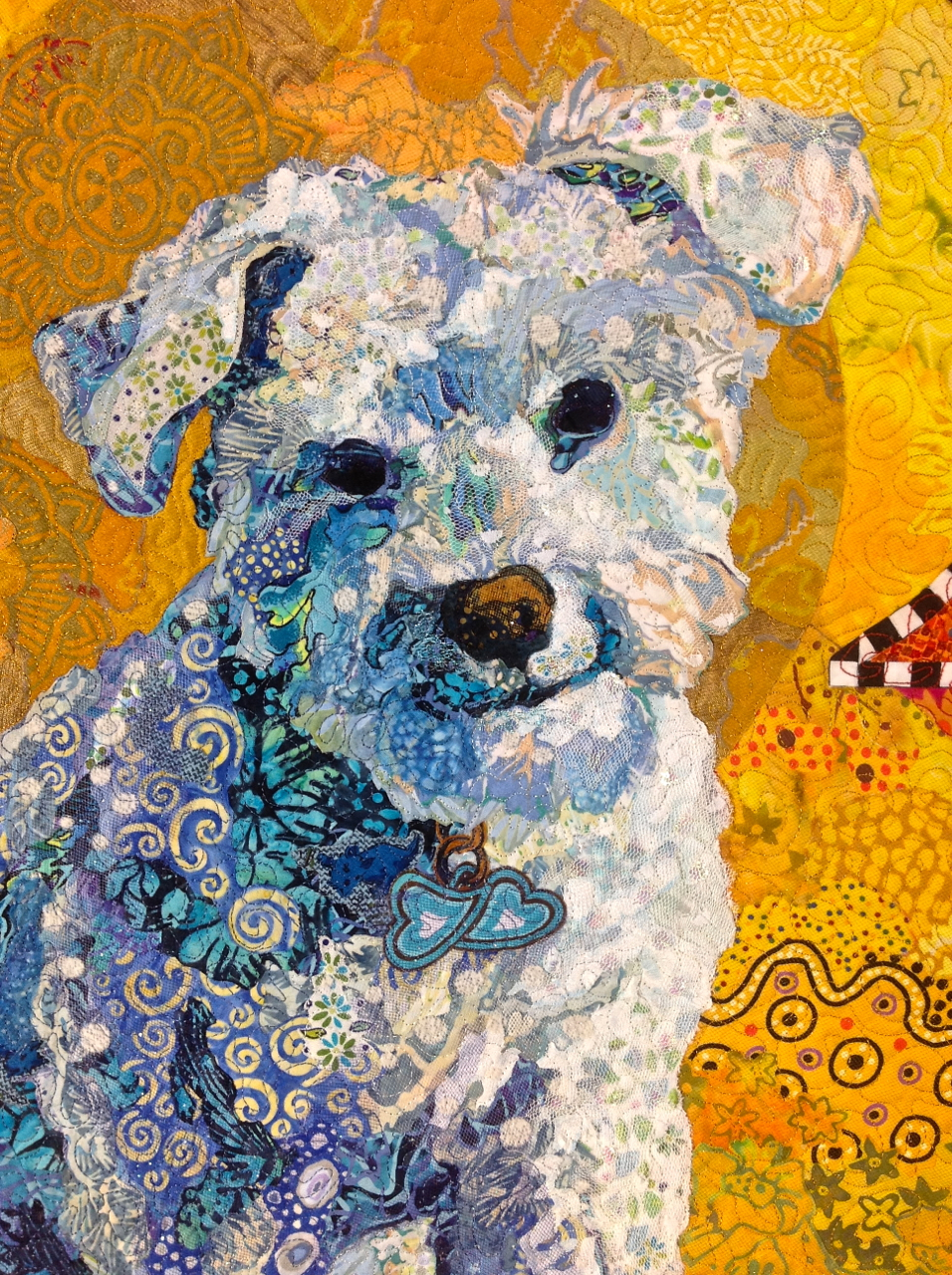
Kiiora the budgie flowed together with hardly any hitch. The down draft and updraft happened almost simultaneously. Then it was on to the final tweaks of the dental draft.
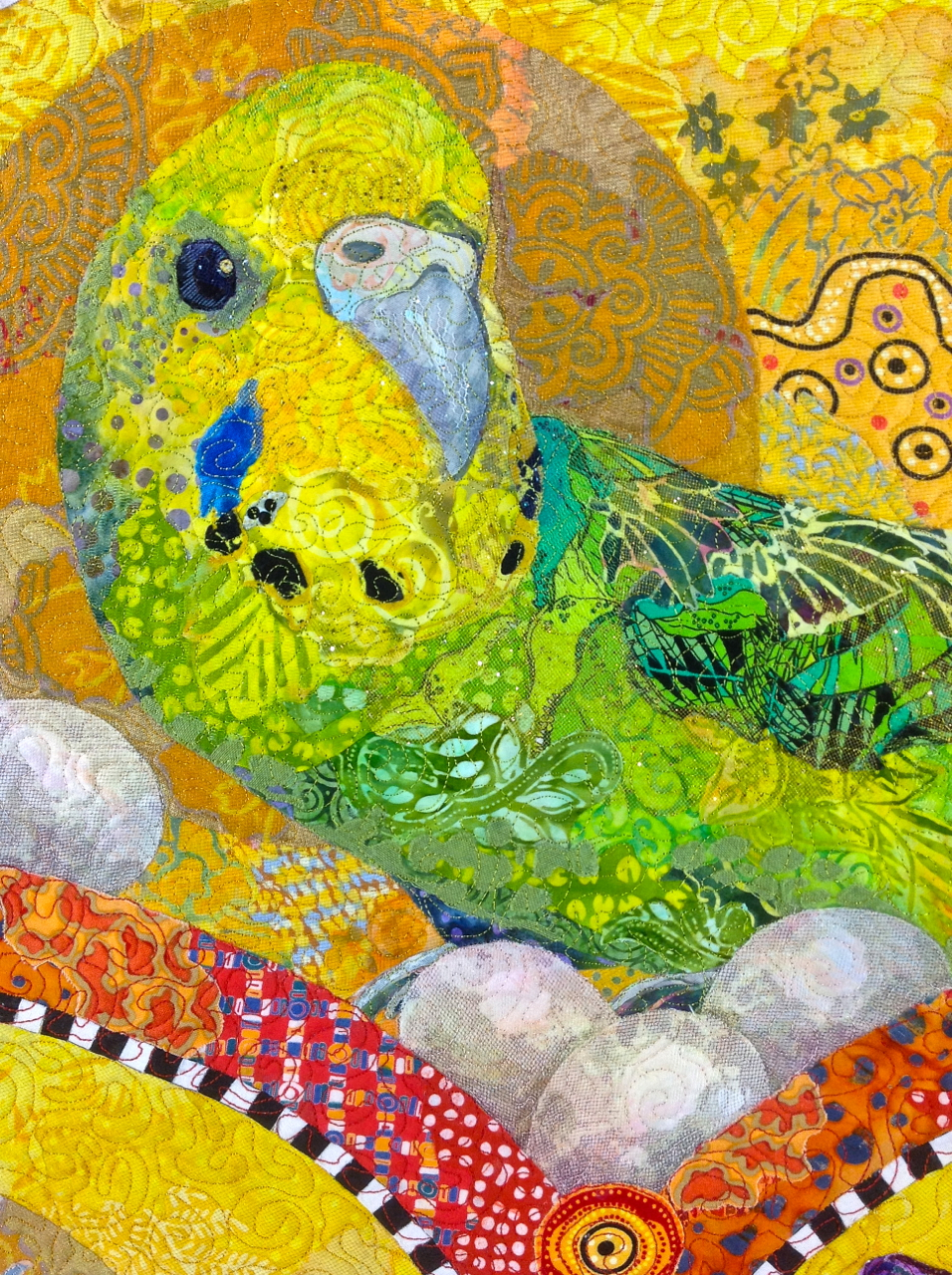
Images that flow together like Kiiora the budgie did are the exception. Often, at some point, there’ll need to be a fairly major revision. I revised the front leg of “Crocodylus Smylus” three times before I was satisfied. Djinni cat was another example. While working on the background, it became clear to me that her tail disappeared into the corner. What to do? Ahhh, I see, it needed to be moved to a different angle.
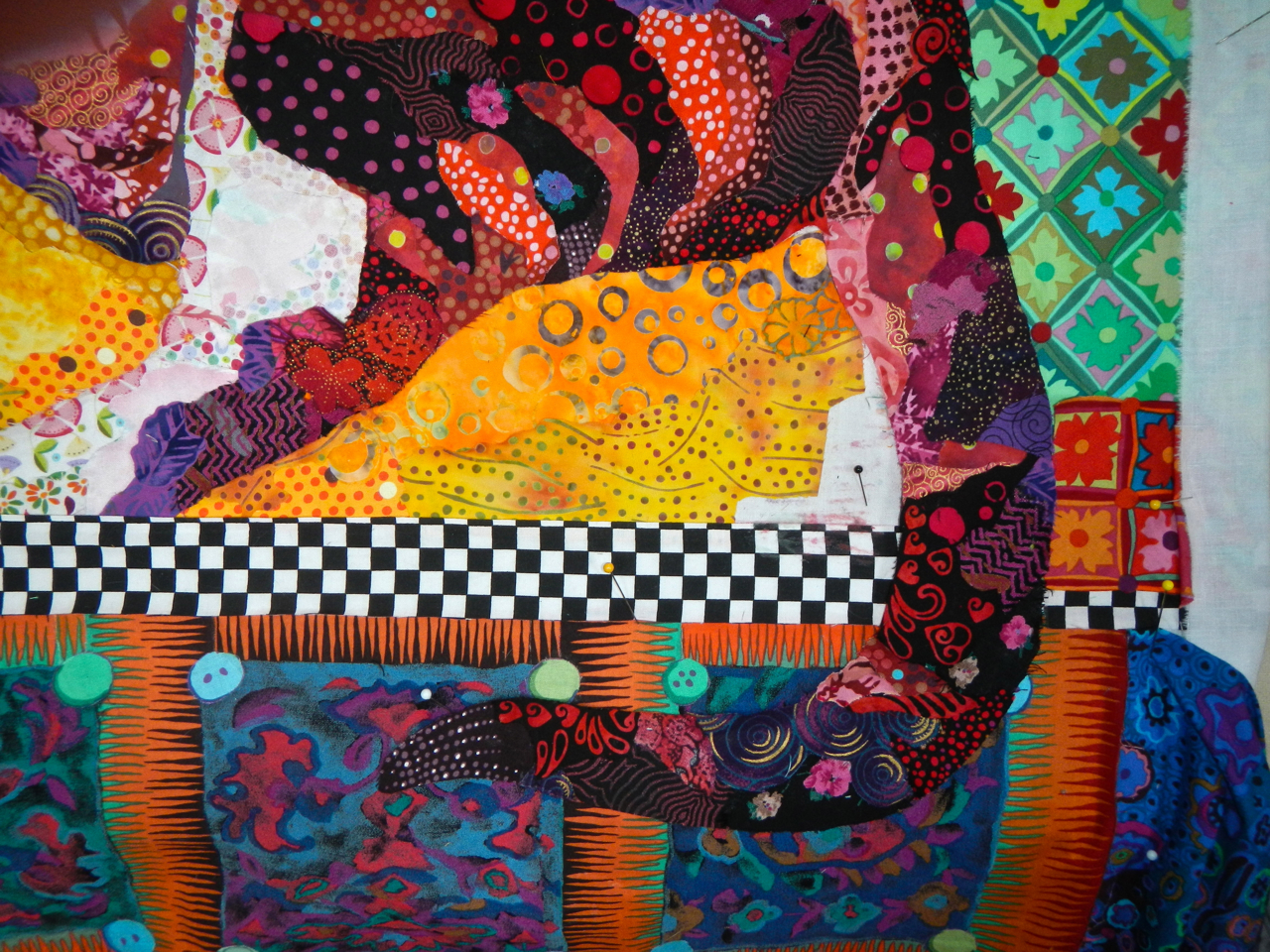
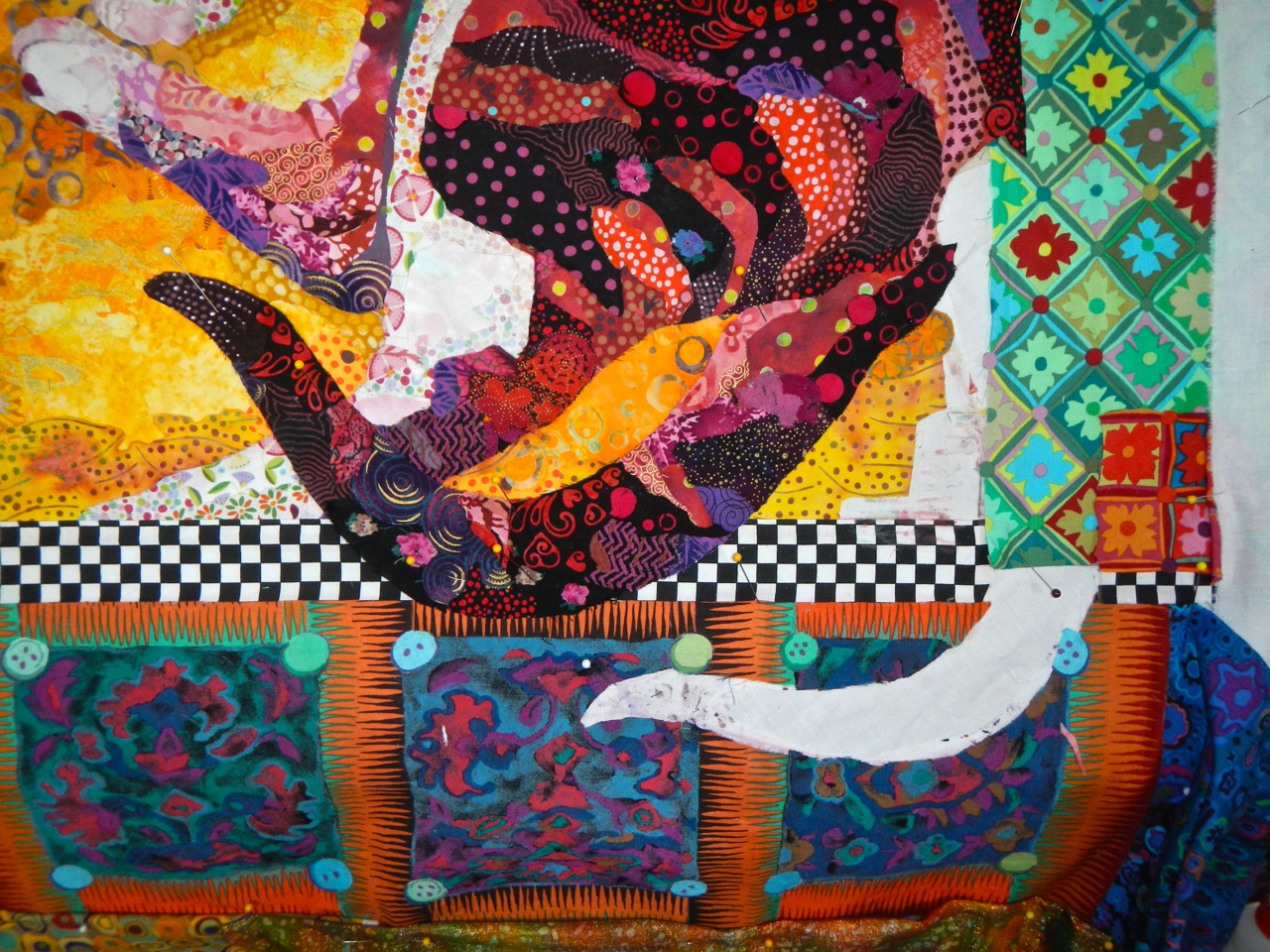
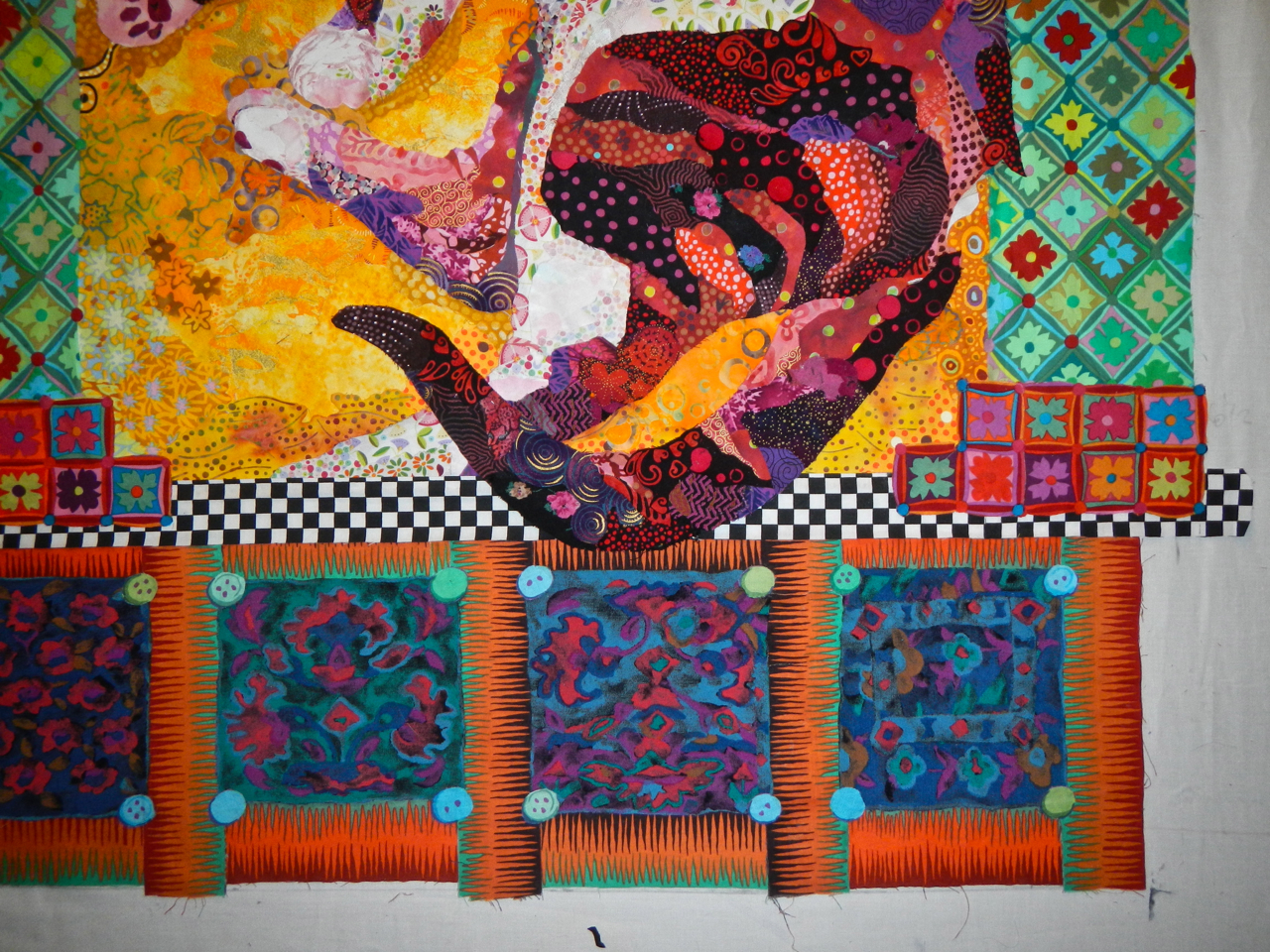
Once the tailectomy was complete I could work on finishing Djinni as I had the other two, adding final detail, and boosting highlights and shadows with tulle and other translucent fabrics. Plus that sparkle.
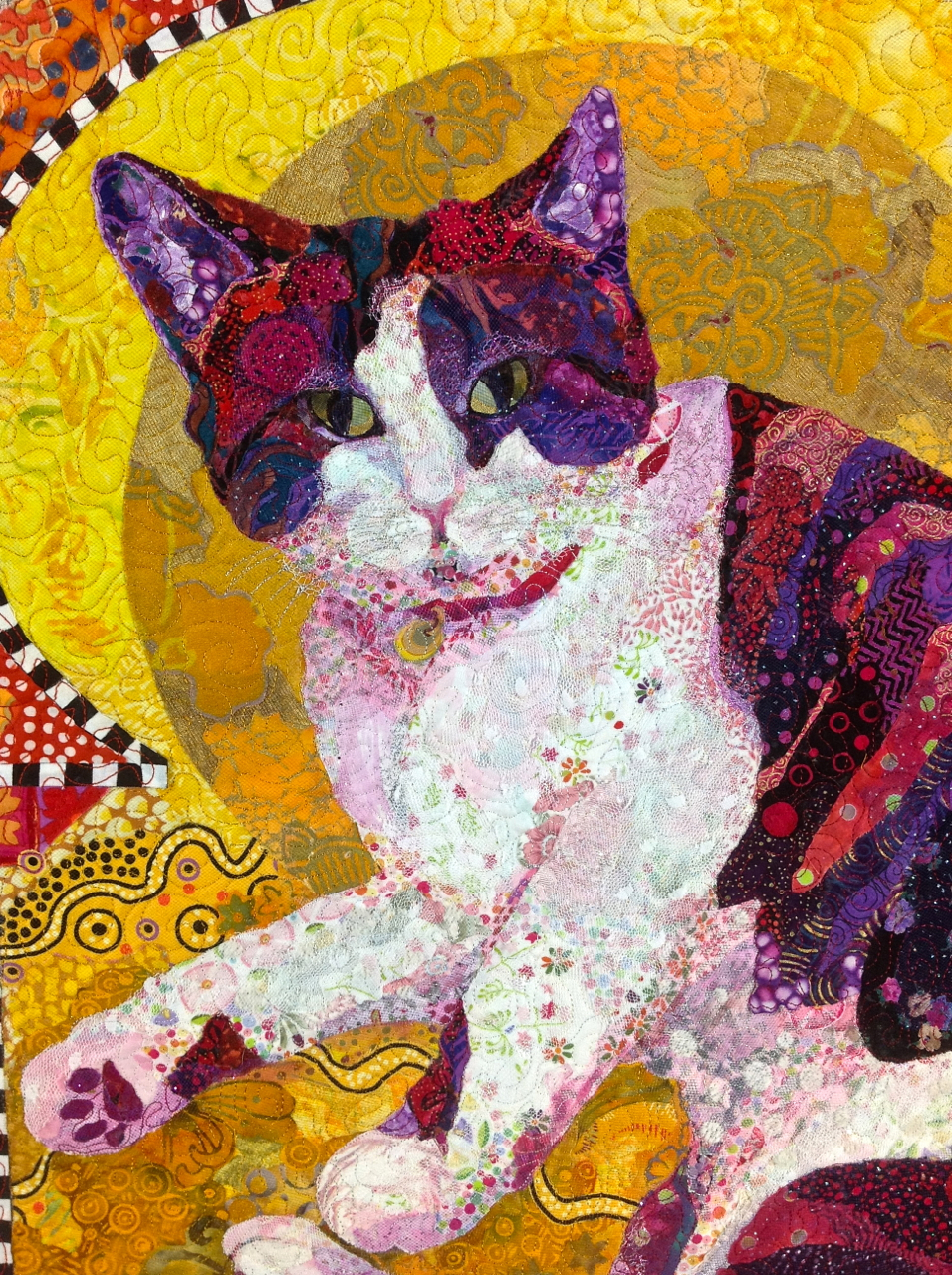
Each subject in “Golden Temple of the Good Girls” followed a different path to completion. I’m sure Lamott would agree that that’s the nature of creativity. If the experience of creating were the same each time, it would cease being art. It would be manufacturing.
Postscript
Since these posts about “Golden Temple of the Good Girls” were published, Kiiora has sadly passed away. She lived almost 9-1/2 years which is a feather above average for a budgie. Possibly due to how many eggs she laid (and the toll it takes on a little body), she developed a tumor in her reproductive tract. We had a wonderful vet who helped us enjoy her personality for an extra 8 good months by draining her abdomen every couple weeks. Yes, we do anything we can for our pets, don’t we. Kali and Djinii are still young and we look forward to enjoying many more years of their endearing traits and those of Felix our tripod rescue dog who joined us last year.
Pets punctuate our lives. They add commas, periods, question marks, and sometimes exclamation points to our existence. We live so much longer than they do that we—or at least I—set entire periods of our lives inside of parentheses. (Our first pets, “the pups”, Daisy and Hassan, and Shadow cat, in the time before our son Sam.) (The years when we had Pippin and Max the cat, and Sam was in grade school.)
I make quilts of my pets not only so that the images remind me of them when they’re gone. The act of making the quilt—the thought and effort—helps me to appreciate them—if they’re still with us or not. When I’m doing a portrait, it forces me to really look, to really see my subject. That penetrating observation goes beyond the surface likeness. A good portrait captures not just the likeness but something of the personality of the subject.
The time I spent making the “Golden Temple” of my “Good Girls” is precious to me—as are they.
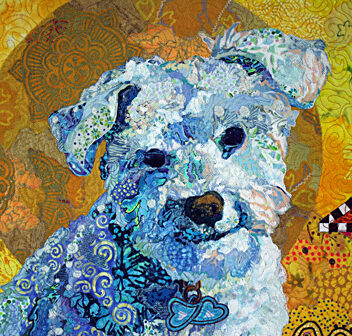






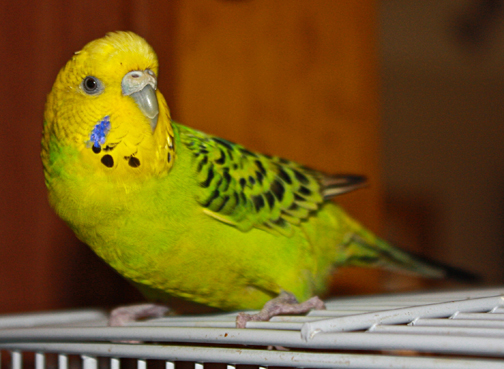
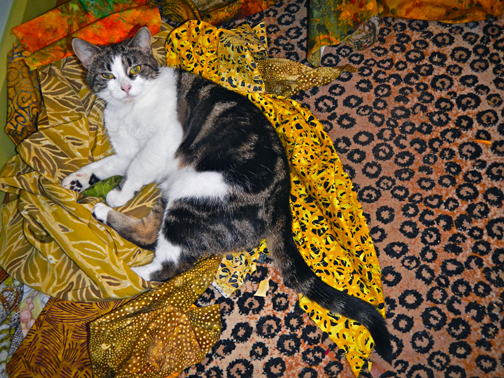
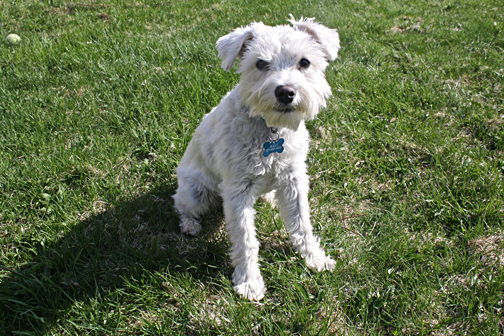
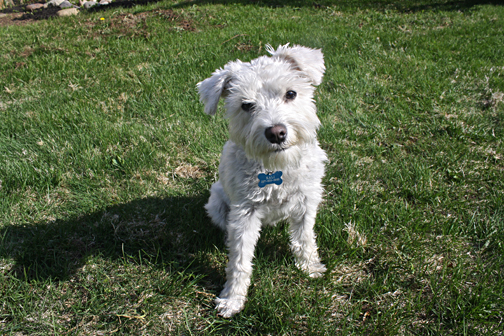
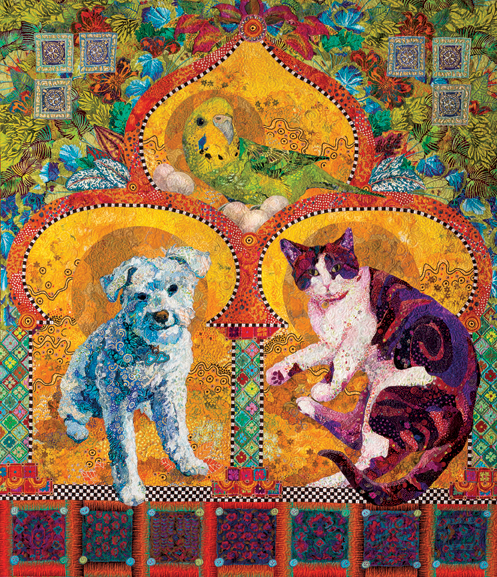
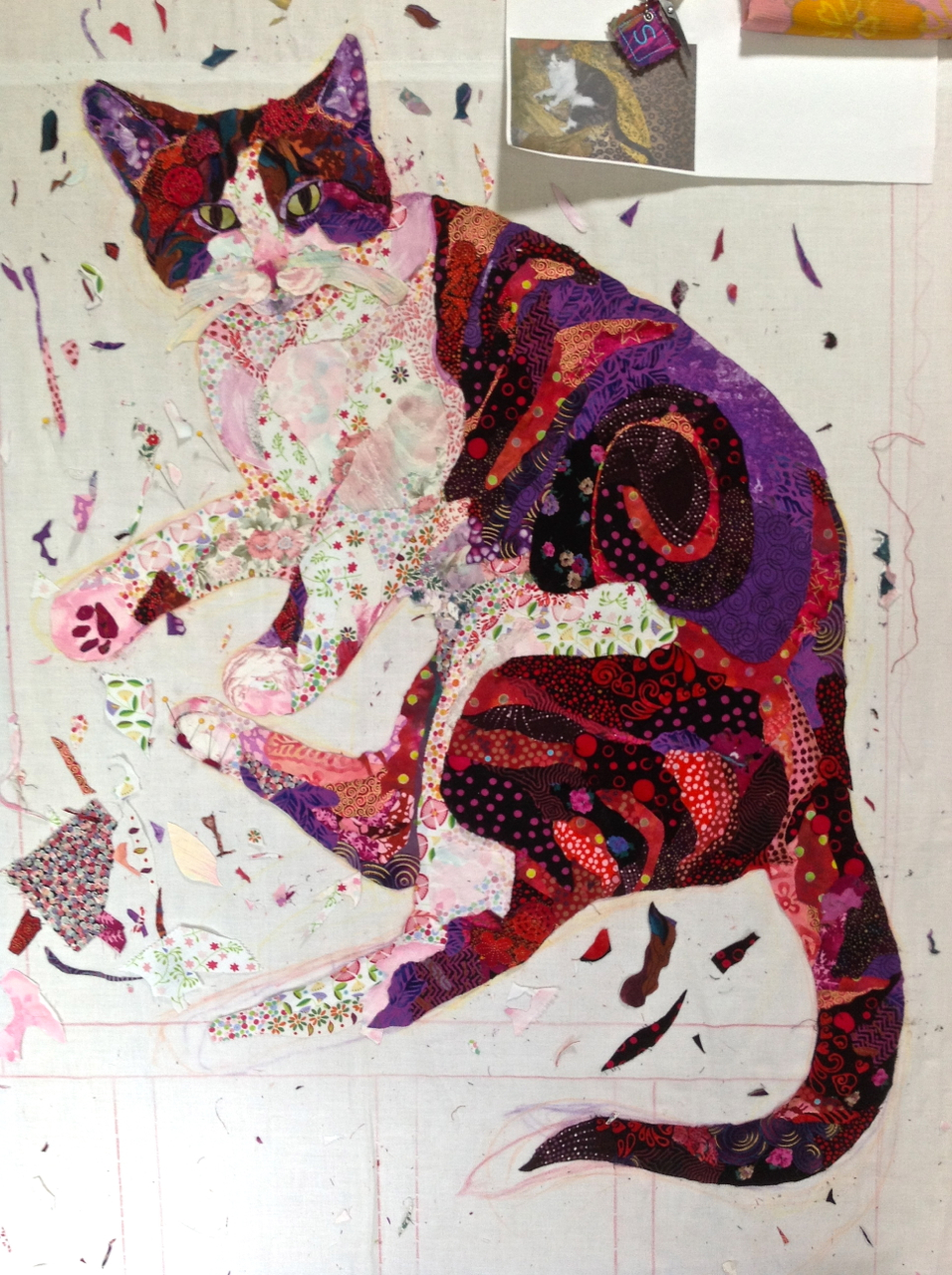
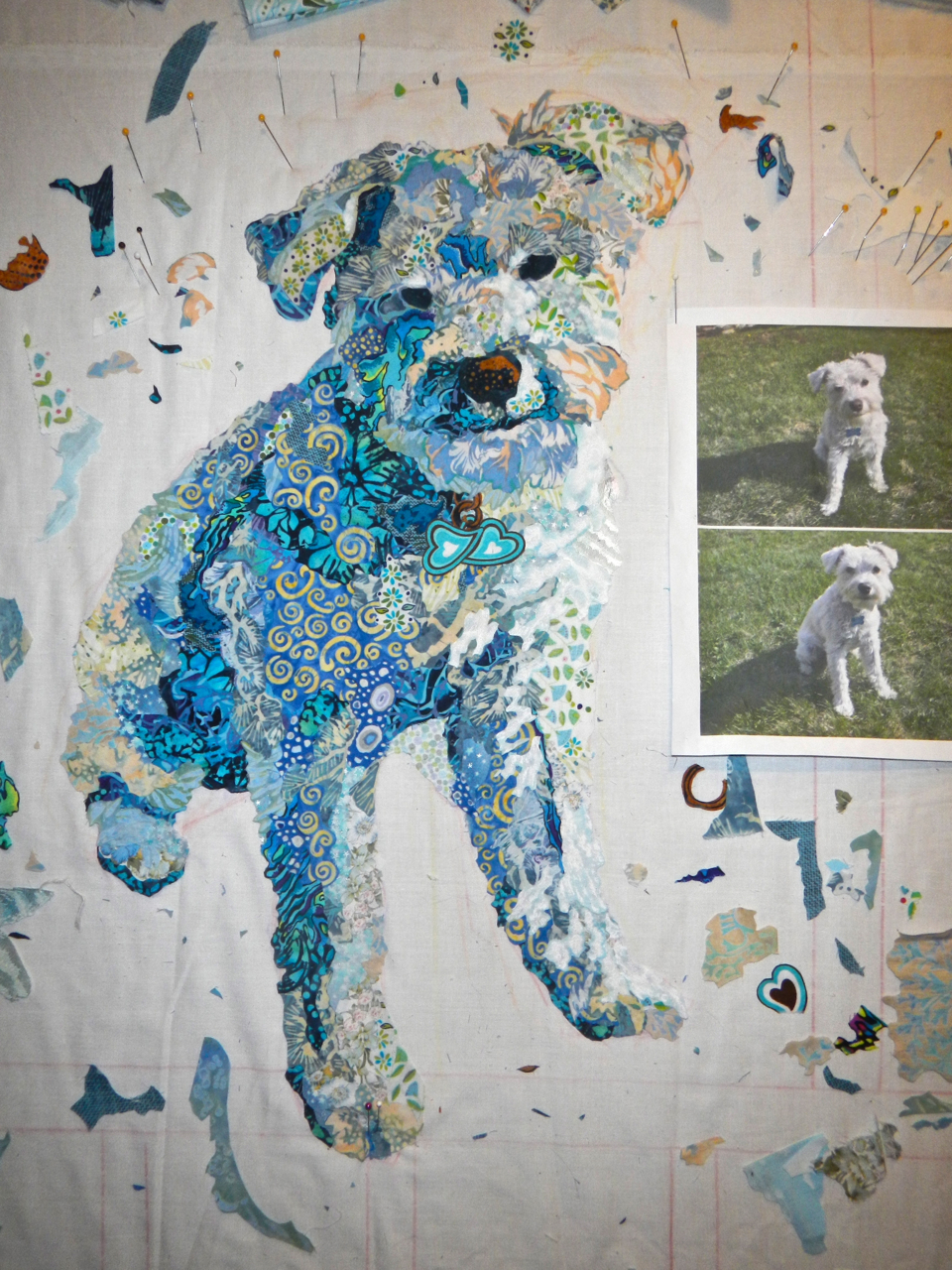
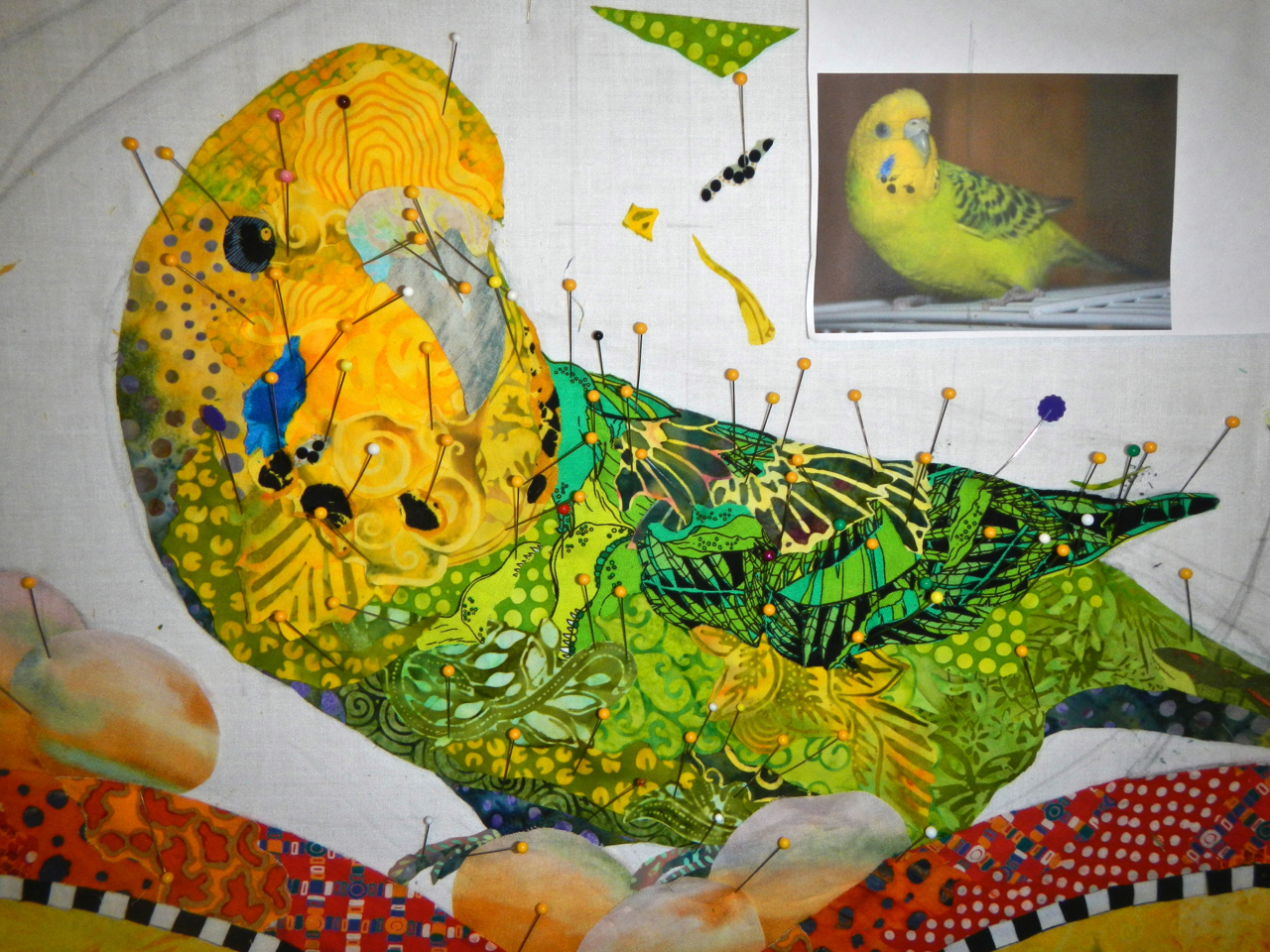
Such great inspiration. I have started doing some collage work – just so much fun.
Such great inspiration. I have started doing some collage work – just so much fun.
This is something I am really interested in and I so enjoy reading your Facebook page,and always look forward to it. Thank you!
This is something I am really interested in and I so enjoy reading your Facebook page,and always look forward to it. Thank you!
Sorry for your loss of Kiiora. She will always remain adorable thanks to your artistry.
If you ever run out of ideas for a blog, I would be most interested in one on how you decide on backgrounds for your pieces.
Thanks for the idea. That is one I’ve considered.
Sorry for your loss of Kiiora. She will always remain adorable thanks to your artistry.
If you ever run out of ideas for a blog, I would be most interested in one on how you decide on backgrounds for your pieces.
Thanks for the idea. That is one I’ve considered.